Disclosure: Meeple Mountain received a free copy of this product in exchange for an honest, unbiased review. This review is not intended to be an endorsement.
Have you heard of Sid Sackson?
For most gamers new to the hobby, my guess is that you have not. That’s not necessarily a good thing or a bad thing, but for those looking to learn more about the hobby (whoops, The Hobby™), I find it fascinating when we can celebrate designers who made games 40 or 50 years ago.
Case in point: Bazaar, a game that was first published in 1967 by Sackson and the 3M Bookshelf Games line. Along with a game called Acquire—maybe Sackson’s most influential addition to tabletop gaming—Bazaar and a handful of other games were published as a way to give gamers products with a small footprint and easy-to-learn rules that could be played in under an hour.
Bazaar has made its way through a half-dozen publishers over the years; on its own, I’m not sure Bazaar would be enough to warrant a new version. Eagle-Gryphon Games recognizes the history of the design and decided to package Bazaar along with another Sackson design from the 1980s, Samarkand, and released the duo as simply Samarkand Bazaar in a package released in 2022.
But wait, there’s more! Tripling down on the value proposition, Eagle-Gryphon packaged one more small card game in the Samarkand Bazaar box: Samarkand Market, a reimagined version of Sackson’s 1998 game Business using many of the components from the main box along with a small set of cards to drive the action.
Three games, all for about $40. That’s quite a deal, no matter how the games turned out. How have Bazaar and Samarkand aged over the years?
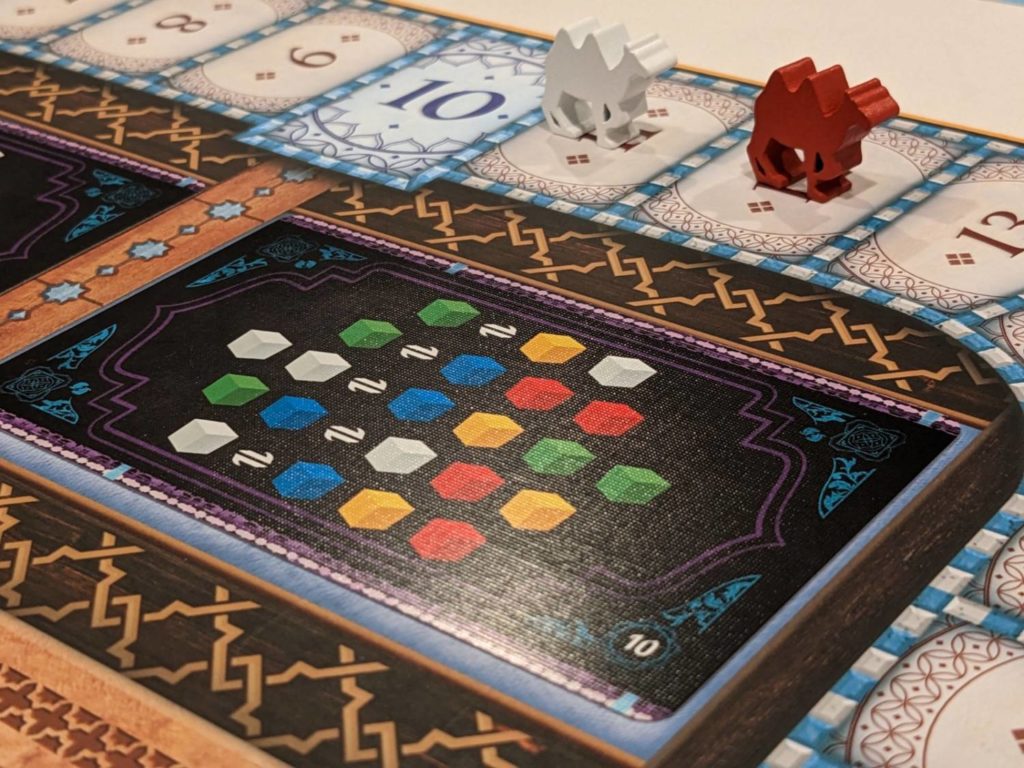
Bazaar
The 1967 game Bazaar has gotten an upgrade in polish thanks to the fine people at Eagle-Gryphon; the board is mainly a scoring track along with an area where cards reside for all players to see, but it is a classy-looking and uncluttered space for players to get the job done.
2-5 players take turns rolling a die to get one of five colored cubes (goods) in the game, placing goods on the player aid that doubles as a sort of warehouse, with space for 10 goods.
If a player doesn’t want to roll a die, they can take an existing good and trade it using the two “Exchange Rate” cards on the board to turn few goods into many, or many into few. This is important because of the scoring mechanic. When a player has collected a series of goods that match one of four face-up “Ware” cards from a market, they turn in their goods to score points…but, the fewer remaining cubes there are in that player’s warehouse, the more points they are able to score.
All Ware cards require exactly five cubes; savvy players will recognize early on that scoring Wares with zero or maybe one cube left in their warehouse is the best way to guarantee a chance at victory. Even the tiebreaker plays into this—scoring as many points as possible by buying the fewest number of Wares breaks a tie.
Play continues until two of the four Wares stacks are empty, at which point the game ends immediately. When the first Wares stack empties out, scoring ramps up for the rest of the game, giving players who are behind a better chance at making things competitive near the end of play.
Bazaar is mildly interesting fare. I played this game three times over the course of only two hours with my wife and daughter; it’s easy to teach and games with three or less players will only take about 30 minutes. The wow moments aren’t going to wow everyone; a player who is able to quickly determine trades that will get them the right combination of cubes to ensure they purchase Wares by completely emptying their warehouse will usually win.
While the actions will be easy to decipher for a nine-year-old, the strategy behind minimizing the negatives of purchasing Wares with a full warehouse will prove more difficult. The replayability of Bazaar at first seems limitless; the reality is that while there are 10 different Exchange Rate cards in the box, any two cards will just lead to different color combinations available, not really any differences in strategies, powers, scoring, etc.
I thought Bazaar was only OK, but my family was direct: “no thank you” was the response to the open question of whether they would want to play this beyond my review plays.
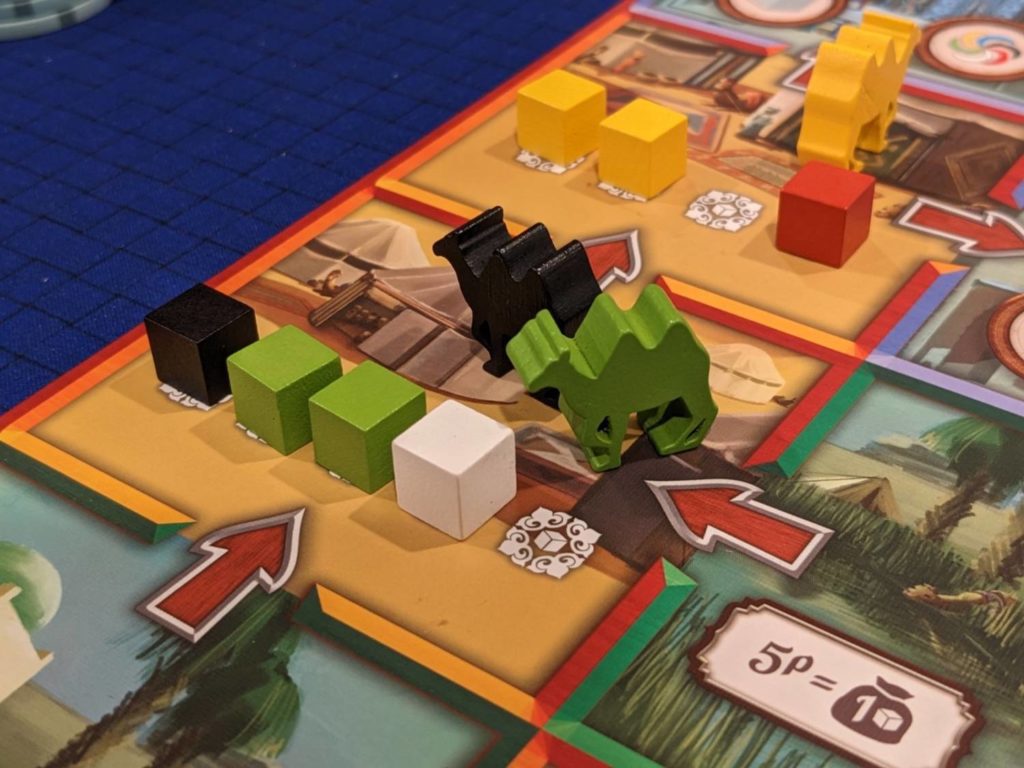
Samarkand
“Gosh, this looks a lot like that game where you were stacking up workers then trying to move around the board.”
Everyone who I’ve shown Samarkand has said the same thing, roughly the line above. And they are right: Samarkand looks a heck of a lot like the game Istanbul. Now I have a different question: did Istanbul rip off the look and feel of Samarkand, a game released almost 20 years BEFORE Istanbul?
A question for another day. For now, I’ll say that Samarkand is the reason to buy the Samarkand Bazaar package.
The gameplay in Samarkand is so much better than what Bazaar has to offer. It starts with the straightforward approach. Each player is a trader who is racing to end the game by having 500 “piasters” in their possession. (The game’s setting is “exotic Asia Minor.”) After doing what made the most sense—swapping out the game’s paper card money for my Iron Clays poker chips—I joined other players to set about moving around the 4×5 space board to collect goods cubes then sell them at various city spaces for a lot of cash.
That’s really all there is at stake here. And in the classic approach of “easy to learn, difficult to master”, Samarkand dives in and offers players a puzzle: how can I move around this map the fastest and sell my cubes?
The answer: push your luck. On a turn, players can move their trader pawn one space in the direction of the arrows pointing into or out of their current space, then take the required action there. As an alternative, they can roll a six-sided die instead, then move exactly that number of spaces.
The definition of fun, then? Deciding to not move one space, then rolling the die, and coming up with…a one.
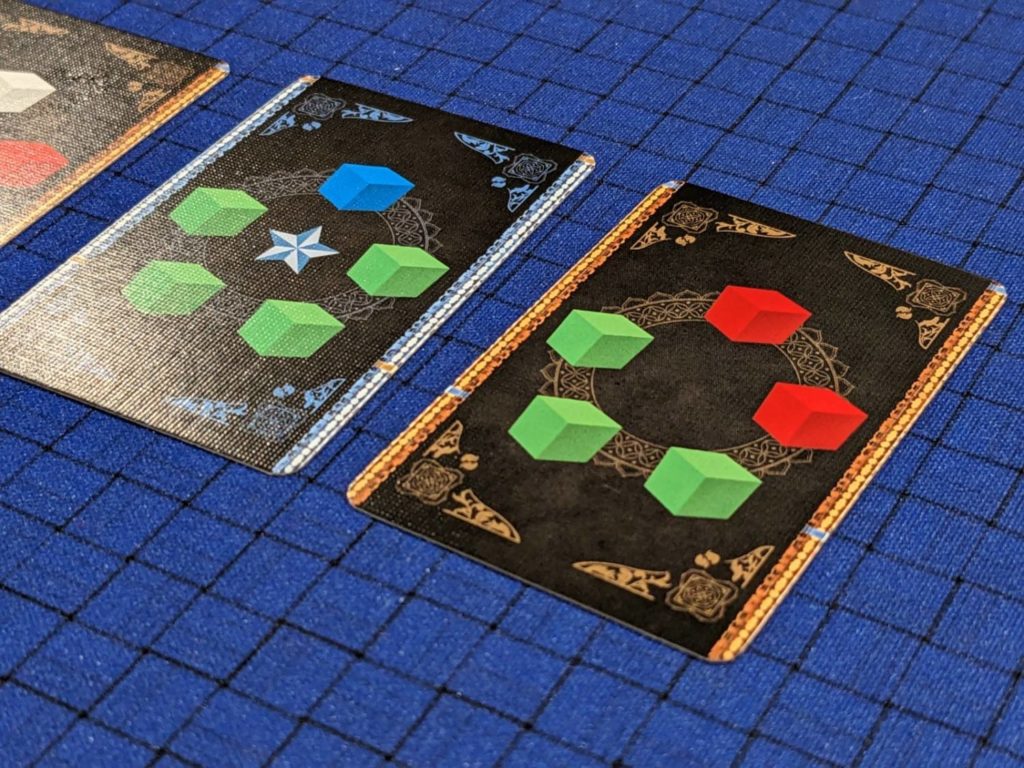
The die is the best part of Samarkand, because if you strike gold, you might get a five and move all the way across the map. You might get hosed, and roll a one or a two. You might get hosed again, or really come up aces, by rolling the backwards arrow, which means you can move backwards one space against the grain and take that space’s action.
No matter what, using the die costs five piasters. Yep, you might pass on moving one space for free, then pay five piasters to roll the die, and come up with a one.
Now, I know what some of my hardcore strategy friends are saying right now: blasphemy! Tying my movement to a game of chance? Not knowing for sure which action I will take until taking my turn?
I get it. But don’t worry—games of Samarkand don’t take very long. They really don’t take long if you are efficient and find ways to sell the game’s most valuable goods—black or white cubes, which are in shorter supply than the other four colors—while buying on the cheap by visiting “Oases” spaces that allow a player to buy four cubes for 20-25 piasters instead of 30. (You can also buy a single cube at any Oasis space for five piasters, to save money.)
Samarkand isn’t perfect. It doesn’t give players equal turns, a problem shared by Bazaar but emblematic of the time period when the games were released. There is player elimination in this game, or at least the threat of it; while this hasn’t happened in my plays, running out of money is a death knell for a player.
Samarkand’s worst offender is its length; it doesn’t scale to player count, so in a five-player game, the win condition is still 500 piasters, and the board state is even more chaotic because publicly-available goods cubes at the Nomad Camp spaces might change every single turn. This spikes into a tough issue: there’s a bag of goods cubes, with cubes that are drawn whenever someone needs to buy more. If the bag ever runs out, all players have to reduce their secret holdings of goods to 12 cubes, which could be killer if someone was saving up to deliver 6-7 goods of a single type to make the most money.
Across five players, Samarkand runs too long. Stick to 2-3 players and you’ll be in great shape.

But Wait, There’s More!
Yes, Samarkand Bazaar has two Sid Sackson games included. But what if I told you that you also get a THIRD game to go along with that?
Samarkand Market, based on Sackson’s Business from 1998, is a bidding game where players have to adjust to a market that is constantly in flux. In each of the game’s 12 rounds, players will bid to acquire a lot of 3-5 cubes (again in one of six colors) which will then be sold against one of three face-up market cards to make money.
The bidding on the lots is fairly interesting, especially when you know what color cubes players are looking for to complete a set for one of the face-up markets. And knowing that you can get an edge by going cheap on the bidding (minimum bid is $5) makes many of the decisions a bit juicier than if bidding was not required.
Samarkand Market is ultimately fine. It’s not the reason to buy this set, but it’s a nice throw-in that can be played with older kids and it’s another opportunity to swap out the included money cards for your set of fancy poker chips. It’s easy to teach and plays in under 30 minutes regardless of the player count.
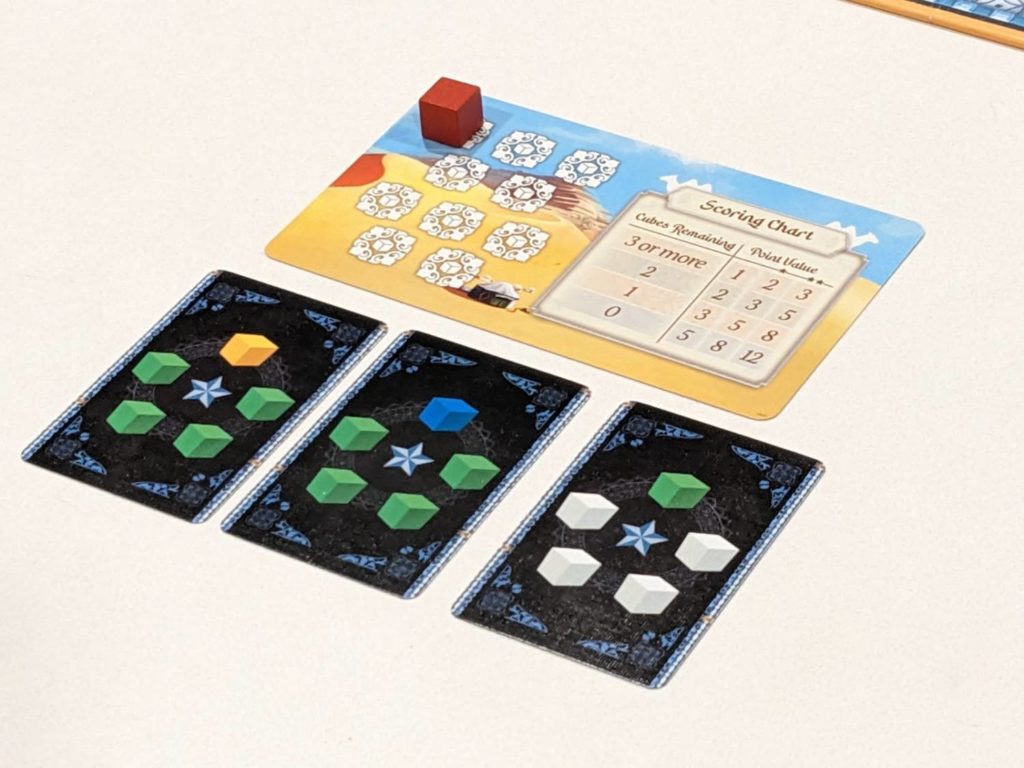
The Value Proposition is Ridiculous
The best game in this set is Samarkand; over the course of eight plays across the set’s three games, that much is very clear. Bazaar is fine, and might scale up for certain players who like the idea of the cube trading mechanic. Samarkand Market is a toss-up; it’s fine, but it’s quick, and serves as a great filler between or before either of the other games.
But knowing that you can get all of this for about $40? That’s a steal. I think Samarkand alone is worth the price of admission, and Eagle-Gryphon is tossing in two other games. Combine this with the high-quality production that Eagle-Gryphon is known for, and you’ve got a very handsome package that fits family-weight play as well as strategy gamers quite well.
The beauty of older games is on full display here. Two of the people who joined me for games from this package called the designs “elegant.” There’s a timeless feel to how simple the games are to pick up and then have so much depth to fully master. If you like your games aged a bit, Samarkand Bazaar is a great place to start!


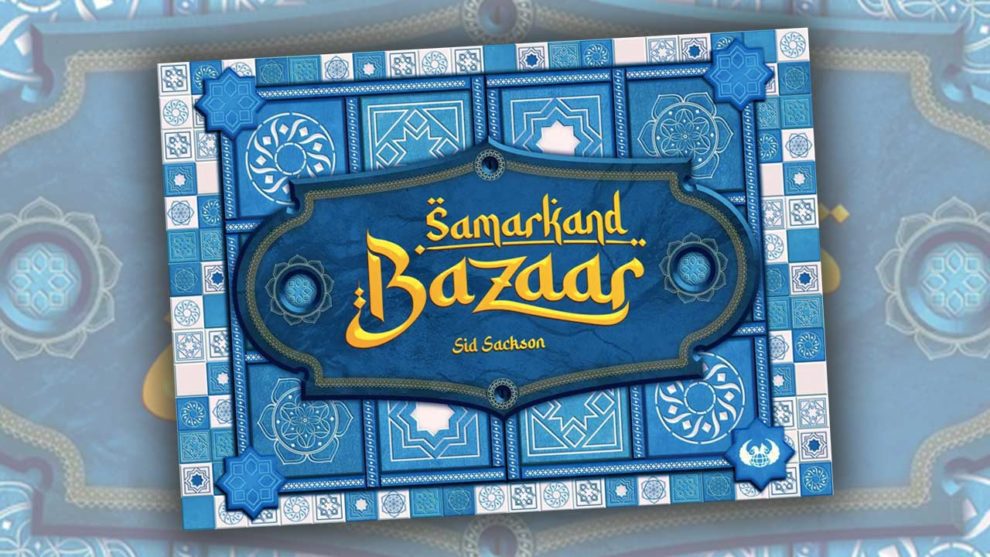








Add Comment